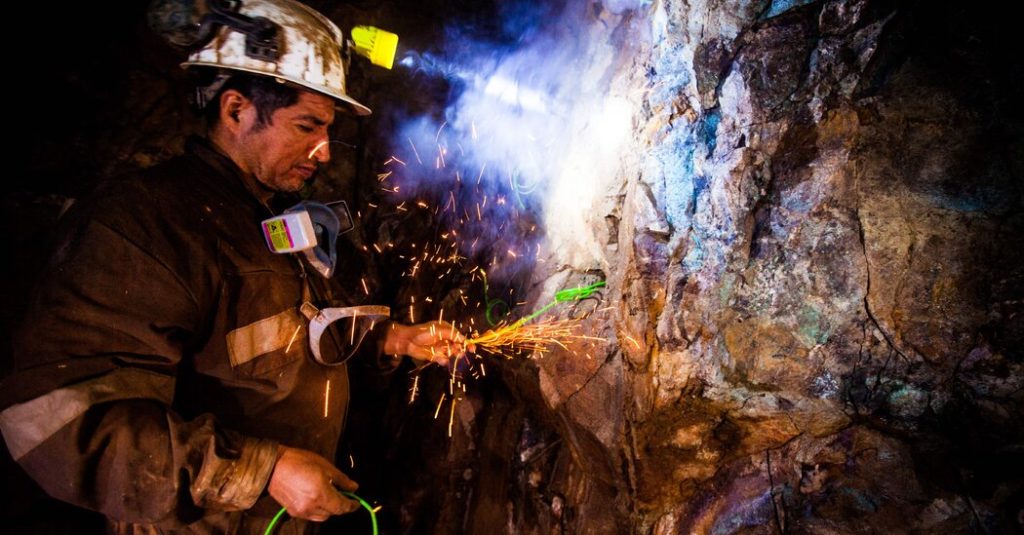President Trump signed an executive order Tuesday directing his commerce secretary, Howard Lutnick, to begin an investigation into whether foreign production of copper and imports of the material into the United States poses a risks to America’s economic and national security.
White House officials said that, depending on the results of the investigation, new tariffs could be applied on foreign copper, a material that is widely used in manufacturing and construction but is also key to the U.S. military and emerging technologies like artificial intelligence.
White House officials were scant on details during a call on Tuesday afternoon, including when the investigation might conclude, what rate tariffs might be set at, or when they would go into effect. It would all be figured out in “Trump time,” one official said repeatedly, which apparently meant quickly.
The potential tariffs would help to protect the domestic copper industry that the White House says has been undermined by unfair trade practices by other countries, and is struggling to compete. Copper is, among other things, an essential component in the building of ships, aircrafts and tanks. The Trump administration framed it on Tuesday as an issue of national defense as much as an economic one, saying the metals would be needed for electric vehicles and A.I., and that geopolitical turmoil could cut the U.S. off from needed supplies.
“Tariffs can help build back our American copper industry, if necessary, and strengthen our national defense,” Mr. Lutnick said. “American industries depend on copper, and it should be made in America, no exemptions, no exceptions.”
“It’s time for copper to come home,” he added.
But, like the tariffs on steel and aluminum that President Trump is promising to reinstate next month, copper tariffs will also raise costs for a variety of other industries that depend on the metal, and could generate a backlash from them. That includes makers of automobiles, electronics and telecommunications equipment, as well as construction companies, which use copper for plumbing, roof construction and other uses.
The tariffs could also spark new fights with foreign countries that ship metal to the United States. The largest foreign source of copper for the United States is Chile, which sends $4.63 billion of the metals to the U.S. each year, followed more distantly by Canada, Peru, Mexico, and the Democratic Republic of Congo. China is also a major global producer of copper, but sends relatively little to the United States because of previously imposed tariffs.
White House officials say that Chinese copper production has still driven down global prices, and that China had been snapping up copper resources globally.
Peter Navarro, a senior counselor for trade and manufacturing, said in a call with reporters Tuesday that China had “long used industrial overcapacity and dumping as an economic weapon to dominate global markets” and systematically undercut competitors from other countries. “It is now using that same model to gain control of the world’s copper markets,” he said.
Asked how the president landed on the issue of copper specifically, one of the administration officials on the call Tuesday said that “the boss is playing three dimensional chess in this world and he sees things far in advance that the rest of us don’t.” The official referenced an interview from the 1980s in which Mr. Trump talked about trade with Oprah Winfrey, which, the official explained, “presaged a lot of the ways he would think about how foreign governments were cheating us, and how we had to respond with things like tariffs and reciprocal trade.”
Mr. Trump has threatened to impose tariffs on a variety of imports, including steel, aluminum, copper, automobiles and pharmaceuticals. He also came within hours earlier this month of imposing tariffs on Canada and Mexico, saying the countries were not doing enough to stop the flow of drugs and migrants into the United States. He paused those tariffs for a month, but said this week they would go into effect Mar. 4 as planned.
Mr. Trump also imposed an additional 10 percent tariff on all products from China, which sparked retaliatory tariffs from the Chinese. And he has introduced a plan to dramatically reform U.S. tariff rates on other countries, by changing them to reciprocate the tariff levels that other countries charge the United States, as well as capturing certain trade behaviors he deems unfair.
The copper investigation will be carried out under Section 232 of the Trade Expansion Act, which allows the president to impose tariffs on foreign products in the interest of national security. By law, the secretary of commerce has 270 days to present findings from the investigation to the president.
Copper prices have climbed this year, ahead of expected tariffs and continued resilience in manufacturing activity, according to a note earlier this month from analysts at Citi. The United States consumed about $17 billion of copper in 2024, and imported about 45 percent of that amount, the analysts said.
Rebecca F. Elliott contributed reporting.








